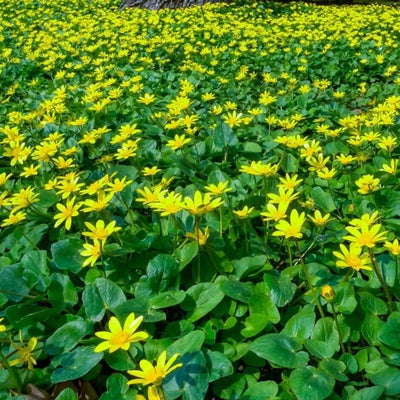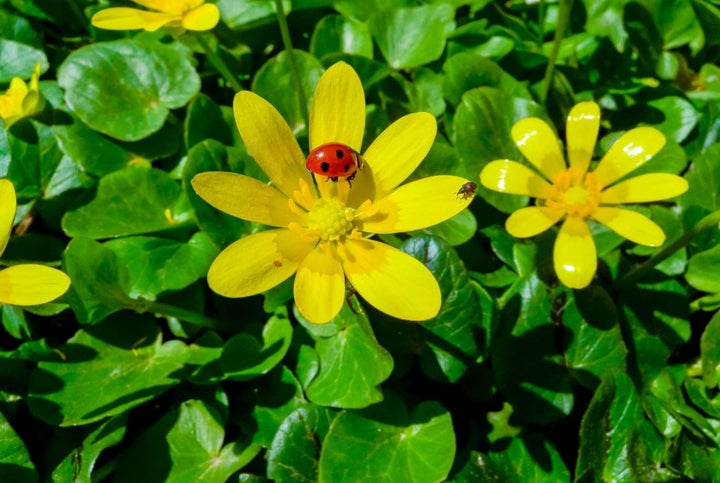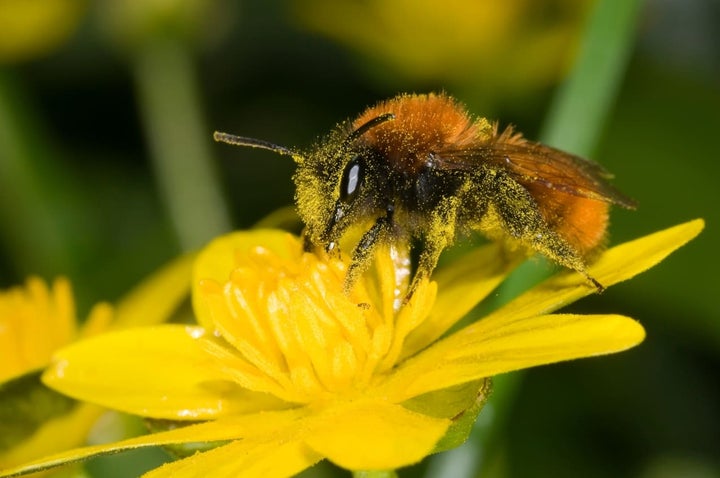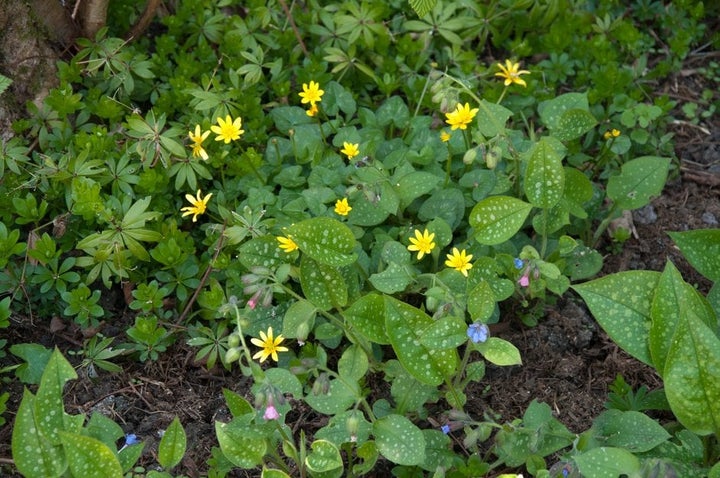
Quick facts
The botanical name for lesser celandine is Ficaria verna
There are four similar-looking subspecies of F. verna, including spring celandine F. verna subsp. verna
Lesser celandine is a UK native and a great plant for pollinators
It has a short growing season and doesn’t bother most other plants
Controlling lesser celandine can be difficult, requiring patience and persistence
What does lesser celandine look like?
This plant has a short growing season, appearing above ground in late February and dying back by late April. It’s heart-shaped, glossy green leaves, often with darker markings at the edges, are held on long stalks, though the plant rarely reaches more than 5cm (2in) tall. Leaves are followed in March and April by bright yellow flowers with eight to twelve petals. Underground, lesser celandine has a network of fine white roots and multiple small tubers.

The four subspecies of lesser celandine are highly variable in their flower colour, number of petals, leaf shape and leaf markings, making it very difficult to tell them apart. Two of them, F. verna subsp. verna and F. verna subsp. ficariiformis, do however produce small bulbils in their leaf axils (the gap between the leaf stalk and stem).
It isn’t necessary to tell whether you have lesser celandine, or one of its subspecies, growing in your garden – they all have a very similar habit, are all good for garden wildlife and if necessary, can all be controlled in the same way.
Did you know?
Despite a similar common name, and both having bright yellow flowers, lesser celandine isn’t related to greater celandine (Chelidonium majus). The latter is part of the poppy, not buttercup, family. It also flowers later, from May to August, and is much taller.
Is lesser celandine a weed?
Lesser celandine is a UK native wildflower, widespread in woods, hedgerows and on the banks of streams. It is a valuable plant for pollinators, providing an early source of pollen and nectar for emerging bumblebees, small flies and small beetles.


As it is only present above ground for a short period in spring, and doesn’t tend to swamp or outcompete other plants, most gardeners are happy to welcome this pretty wildflower. However, as it spreads to form large carpets, it could be considered a weed by those wishing to maintain a fine lawn or manicured borders.
What is a weed?
The term ‘weed’ describes a plant that is growing where it isn’t wanted. Weeds usually thrive in average garden conditions, reproducing and spreading easily. It is up to you to decide what you call a weed and what you choose to retain or remove.
Frequently asked questions about controlling lesser celandine
Here are our answers to your most common questions about dealing with lesser celandine:
How invasive is lesser celandine?
Lesser celandine spreads by small root tubers, which are easily detached and can grow into new plants when soil is disturbed. Plants occasionally produce viable seed and some subspecies produce bulbils in the leaf axils, which root if they become dislodged and land on bare soil. In rich, slightly shaded soil, lesser celandine can spread to form large carpets.
The good news is that lesser celandine doesn’t tend to swamp or outcompete other plants, and is only present above ground for a short period in spring, so most gardeners are happy to leave even large swathes to grow in their garden.
Do I need to get rid of lesser celandine?
No – allowing lesser celandine to grow in a wildlife corner, species-rich lawn or under mature plants is a great way to boost the biodiversity of your garden, support your garden wildlife and benefit from colour at a time when the ground tends to look bare. You could even make a feature of its sunny flowers by planting lots of complementary spring-flowering bulbs and early perennials in the area where lesser celandine grows.

It is, however, a good idea to control the spread of lesser celandine in parts of the garden where you sow seeds or grow small plants, such as veg beds or an alpine rockery, to prevent them being swamped or outcompeted.
What is the easiest way to kill lesser celandine?
Given that lesser celandine only appears for a short time, and doesn’t compete with border plants, the easiest way of dealing with this plant is to simply accept and enjoy its fleeting presence in your garden each spring.
However, if you have lesser celandine growing where it cannot be tolerated, there are a few methods of control:
- Pull off the leaves – removing the leaves as they appear in spring, as well as any subsequent regrowth, weakens plants and prevents them multiplying. Doing this each year will slow its spread and, after many years, could even eradicate it.
- Hand weed – carefully remove plants from the soil with a hand trowel or fork in early spring, before they start flowering. Lesser celandine can spread further with soil disturbance, so try to target plants individually with care. Doing this each year will reduce lesser celandine numbers but it could take several years to clear it completely.
- Hide and smother plants – fill gaps in borders by planting densely with evergreen ground cover plants such as Vinca minor and Pachysandra terminalis.
- Clear beds and cover soil – where lesser celandine is present in large numbers, it may be necessary to lift border plants and cover the soil to exclude light for at least a few growing seasons. It is best to remove border plants when lesser celandine is in leaf, so you can tell if there are any hidden among the roots. Cover the cleared soil with cardboard and a 10cm (4in) thick mulch of bulky organic matter or a layer of biodegradable weed control fabric.
- Improve lawn health – if lesser celandine is a problem in your lawn, follow a good spring/summer and autumn maintenance regime to boost grass vigour and fill gaps, making it hard for lesser celandine to take hold and spread.
Top Tip
Home compost bins are unlikely to get hot enough to kill off tubers, seeds and bulbils, so it is best to add lesser celandine to your council green waste recycling bin instead.
Should I use weedkiller?
No – lesser celandine is resistant to many weedkillers and repeated applications of strong formulations would likely be needed to have any effect. This isn’t good for the environment and would be difficult to apply without causing damage to other garden plants.
Although time consuming, non-chemical methods are the most effective option for controlling this plant.









